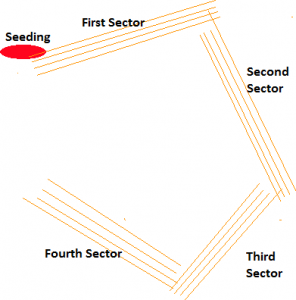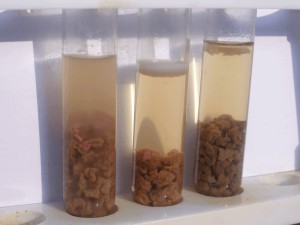CULTIVATION OF BACTERIA: AEROBIC AND ANAEROBIC
CULTIVATION OF AEROBIC BACTERIA
Important steps in Isolation of Bacteria in pure culture:
First – It is required to isolate and grow the bacteria from natural environment to laboratory medium. It requires the knowledge of growth requirements of bacteria of interest.
Second– Bacteria of interest should be separated from other bacteria to obtain a pure culture of one type of bacteria.
Third– Once a pure culture is achieved, maintenance of pure culture without contamination is a task again.
Pure Culture: Population of cells arising from a single bacterial cell, to study characteristics in detail.
Pure Culture Technique– Developed by Robert Koch.
In natural habitat i.e., clinical sample, bacteria of interest usually grow in complex mixed population. It is required to separate the bacteria of interest from the mixed population, as pure culture to study the characteristics of the bacteria in detail.
Generally, initial incubation of clinical sample is done using liquid broth i.e., Nutrient Broth for growing the bacteria or increasing the number of bacteria in the given clinical sample, in laboratory using artificial culture media.
1.Inoculation of Nutrient Broth : The clinical samples should be added to the nutrient broth aseptically to avoid contamination and incubate the nutrient broth for 24 Hrs at 37OC.
In nutrient broth after incubation:
Turbidity : Indicates the growth of bacteria
Transparency: Indicates no growth of bacteria.
2.Streak Plate Method:
To obtain a pure culture , it is required to obtain separate , single bacterial colony. To attain this, well known ‘Quadrant streaking method’ can be used.
The microbial mixture is seeded on the edge of an agar plate with inoculating loop and than streaked out over the surface.
After seeding the culture, first sector is streaked originating from seeding area. After first sector is streaked, inoculum loop is sterilized and second sector is streaked using inoculum from the first sector. Similarly, Third sector is streaked .
In this way, the number of bacteria in seeding area is diluted in first sector, second sector .
Eventually, very few cells remain on the loop in third or fourth sector and single cells dropped from inoculation loop will develop into separate colonies.
Separate single colony is picked up , streaked on fresh plate to get a pure culture.
3.Pour Plate Method
The sample is diluted several times to reduce the microbial count sufficiently to obtain separate colonies. When plating , small volumes of several diluted samples are mixed with molten agar that has been cooled to 45OC before pouring into sterile plates.
Bacteria and fungi are not killed at 45OC for a short exposure. After solidification of agar each bacterial cell is fixed in a place and form an individual colony.
Like the spread plate, pour plate can also be used to determine the number of cells in a population. Plates containing 30-300 clonies are counted. The total number of colonies equals the number of viable bacterial cells.The count of bacterial cells should be multiplied by dilution factor to work. Can also yield isolated colonies. Surface colonies can be used to prepare the pure culture.
4.Spread Plate/Lawn Culture
In this method, small volume of dilute microbial mixture containing around 30-300 bacterial cells is transferred to the centre of agar plate and with the help of spreader, spread evenly over the surface of agar medium. The dispersed cells develops into a single colony.
Numbers of colonies are equal to the number of viable organisms in the sample.
This type of method is used in Antibiotic Sensitivity /Drug Sensitivity Testing.
Spread plate method can be used to count microbial population.
5.Slant and stab culture
Slants of agar in a test tube are generally used for maintaining the bacteria in pure culture. The bacterial colonies are streaked on the surface of slants. Slant culture is also used for various chemical tests such as Citrate utilization test, Urease test and TSI test. In TS test, the culture is streaked on agar surface as well as the culture is stabbed into the butt.
CULTIVATION OF ANAEROBIC BACTERIA
A variety of anaerobic culture methods are available for the culture of anaerobic organisms on the laboratory.
I.Exclusion of oxygen from the medium is the simplest method. And is effected by growing the organisms in freshly steamed liquid medium or deep stab in nutrient agar with 0.5% glucose / 1% ascorbic acid / 0.1% Cysteine / 0.1% sodium thioglycollate or particles of meat in cooked meat broth e.g. Robertson cooked meat medium. With minimal shaking and solidifying rapidly by placing the tubes in cold water.
Robertson’s Cooked Meat Medium (RCM)
Preparation of RCM
1. Procure 500 gm bullock heart, mince it (shredded into small freckles) and add 1N NaOH 1.5 ml. Also add 500ml-distilled water.
2. Simmer the above for 20 minutes in boiling water.
3. Drain off the liquid. (Collect the liquid in another sterile container-, which can be used later for the preparation of Peptone Infusion Broth)
4. Minced boiled (cooked) meat is placed in sterile test tubes.
5. For the preparation of Peptone Infusion broth use the drained liquid ( as above) i.e.,500ml,add peptone 2.56 gm and Nacl 1.25 gm.
6. Steam for 20 mins (100OC) and cool immediately.
7. Add 1ml of pure HCl and filter.
8. Adjust pH 8.2 and steam for 30 mins at 100OC.
9. Adjust pH 7.8. (Peptone Infusion Broth).
10. Add the peptone infusion broth to the tubes with minced cooked meat (as above) in such a way that the level of Peptone infusion broth should be 2.5 cm above the level of cooked meat.
11. Adjust the pH 7.8 and autoclave.
Robertson Cooked Meat Medium
II. Anaerobic jars (McIntosh Fildes’ anaerobic jar)
Material Required
McIntosh Fildes’ anaerobic jar,Catalyst (Asbestos/Palladium),
Resazurin indicator,10ml tap water.
Method
1. Clean the McIntosh Fildes’ anaerobic jar with spirit.
2. Pick up the stock culture of anaerobic bacteria maintained in the Robertson’s cooked meat media and draw approximately 0.1ml of inoculums in sterilized Pasteur pipette.
3. Discharge the inoculums at a corner of blood agar plate and spread by inoculating loop following quadrant pattern.
4. Place the blood agar plate along with charged catalyst.(Charging is done by pre-heating at 100 OC and Risazurin indicator in the jar.
5. Cut open the ‘Gas-Pack’ at the corner with a scissor. Put 10 ml of tap water in the pack and immediately place in upright position in the jar. And tighten the lid.
6. Place the jar in incubator at 37OC for 48-72 hrs.
(Maintenance of anaerobic condition in the jar will be shown by risazurin indicator turning white from its original pink colour.
7. Open the jar after 72 hrs and examine the plate for bacterial growth.
8. Prepare the smear of a suggestive colony, stain with Grams method and observe under microscope.
Exercise
Q1. Explain the principle of ‘Gas-Pack’ system.
Q2.Explain the role of superoxide dismutase and catalase in destruction of superoxide radical and H2O2 in aerobes and facultative anaerobes.
Q3. Exposure to oxygen proves toxic for strict anaerobes.


